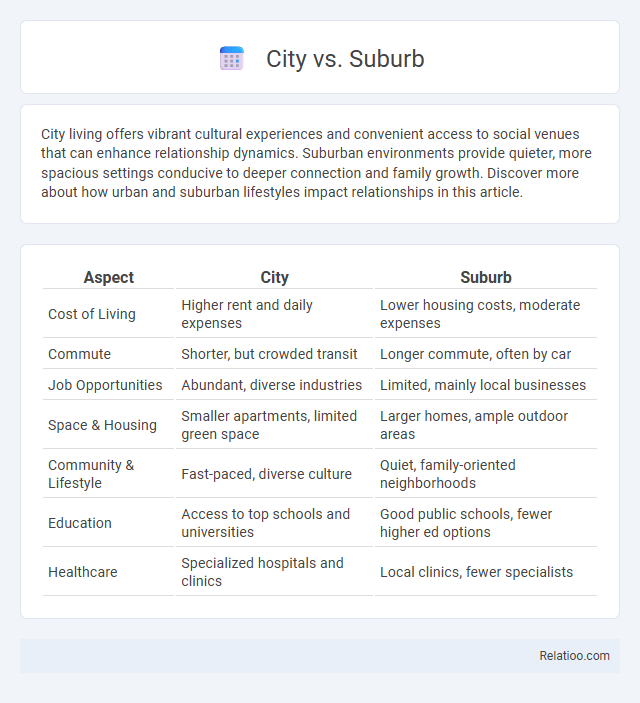City living offers vibrant cultural experiences and convenient access to social venues that can enhance relationship dynamics. Suburban environments provide quieter, more spacious settings conducive to deeper connection and family growth. Discover more about how urban and suburban lifestyles impact relationships in this article.
Table of Comparison
| Aspect | City | Suburb |
|---|---|---|
| Cost of Living | Higher rent and daily expenses | Lower housing costs, moderate expenses |
| Commute | Shorter, but crowded transit | Longer commute, often by car |
| Job Opportunities | Abundant, diverse industries | Limited, mainly local businesses |
| Space & Housing | Smaller apartments, limited green space | Larger homes, ample outdoor areas |
| Community & Lifestyle | Fast-paced, diverse culture | Quiet, family-oriented neighborhoods |
| Education | Access to top schools and universities | Good public schools, fewer higher ed options |
| Healthcare | Specialized hospitals and clinics | Local clinics, fewer specialists |
Urban vs Suburban: Defining the Difference
Urban areas feature dense populations, diverse cultural amenities, and extensive public transportation, offering a fast-paced lifestyle with numerous job opportunities. Suburban regions provide spacious housing, quieter neighborhoods, and family-friendly environments, emphasizing comfort and community over the hustle of city life. Your decision to relocate hinges on balancing access to urban conveniences with the suburban desire for space and tranquility.
Cost of Living: City vs Suburb
Living in the city often entails higher costs for housing, transportation, and everyday expenses compared to suburban areas, where affordability tends to increase with larger spaces and lower property taxes. Suburbs offer more cost-effective options for families seeking better value without sacrificing access to urban amenities. Understanding these differences can help you make informed decisions about relocation based on your budget and lifestyle preferences.
Housing Options and Availability
City housing options often include apartments, condos, and townhomes with limited availability due to high demand and dense populations. Suburbs offer a wider range of single-family homes, larger lots, and more affordable prices, making them attractive for families seeking space and community amenities. Relocation decisions frequently hinge on housing availability, affordability, and lifestyle preferences, as some may prioritize urban convenience while others favor suburban tranquility and room for growth.
Lifestyle and Convenience
City living offers unparalleled convenience with access to diverse dining, entertainment, and public transportation options that suit your fast-paced lifestyle. Suburban areas provide a quieter environment with more space and community-oriented amenities, ideal for families seeking balance and comfort. Relocating requires weighing the trade-offs between urban excitement and suburban tranquility to match your personal priorities and daily needs.
Commute Times and Transportation
City living often features shorter commute times due to extensive public transportation networks, including buses, subways, and bike lanes, which reduce reliance on personal vehicles. Suburbs typically offer more spacious living but involve longer commutes, frequently requiring car travel on highways or park-and-ride transit options. Relocation decisions weigh commute durations and accessibility to transit systems, as these factors significantly impact daily convenience, work-life balance, and overall quality of life.
Employment Opportunities
City locations typically offer a higher concentration of diverse employment opportunities across industries, including tech, finance, and creative sectors, providing you with greater job variety and networking potential. Suburbs often present job options in retail, healthcare, education, and manufacturing, frequently appealing to those seeking work-life balance with shorter commutes. Relocating to emerging metropolitan areas can open access to growing job markets, competitive salaries, and evolving industries, enhancing your career advancement prospects.
Education and Schools Comparison
Urban areas often provide access to top-rated schools and diverse educational programs due to higher funding and resources, attracting families seeking academic excellence. Suburban schools typically offer a balanced environment with strong community support, smaller class sizes, and extensive extracurricular activities, promoting well-rounded development. Relocation decisions frequently prioritize proximity to quality education, as availability of specialized curricula, advanced placement courses, and reputable school districts directly influence property value and family satisfaction.
Access to Green Spaces and Recreation
Access to green spaces and recreation varies significantly between city, suburb, and relocation choices, impacting lifestyle quality and well-being. Cities often offer numerous parks, rooftop gardens, and organized recreational activities within walking distance, promoting active urban living but sometimes limited by space constraints. Suburbs typically provide larger yards, community parks, and outdoor amenities favoring family-friendly environments, while relocation to rural or less densely populated areas maximizes access to natural landscapes, hiking trails, and outdoor recreation opportunities.
Community Life and Social Dynamics
City living offers diverse social interactions and vibrant community events that foster a multicultural atmosphere, while suburbs provide tighter-knit neighborhoods with more stable, family-oriented connections. Relocation decisions often weigh the desire for urban excitement against the appeal of suburban tranquility and stronger local bonds. Social dynamics shift dramatically as cities accommodate fast-paced lifestyles, whereas suburbs emphasize shared community values and slower social rhythms.
Safety and Crime Rates
City neighborhoods typically report higher crime rates compared to suburbs, making safety a crucial factor in your relocation decision. Suburbs often offer lower crime statistics and increased security measures, enhancing peace of mind. Evaluating local crime data and community safety initiatives ensures your chosen area aligns with your personal safety priorities.

Infographic: City vs Suburb
 relatioo.com
relatioo.com